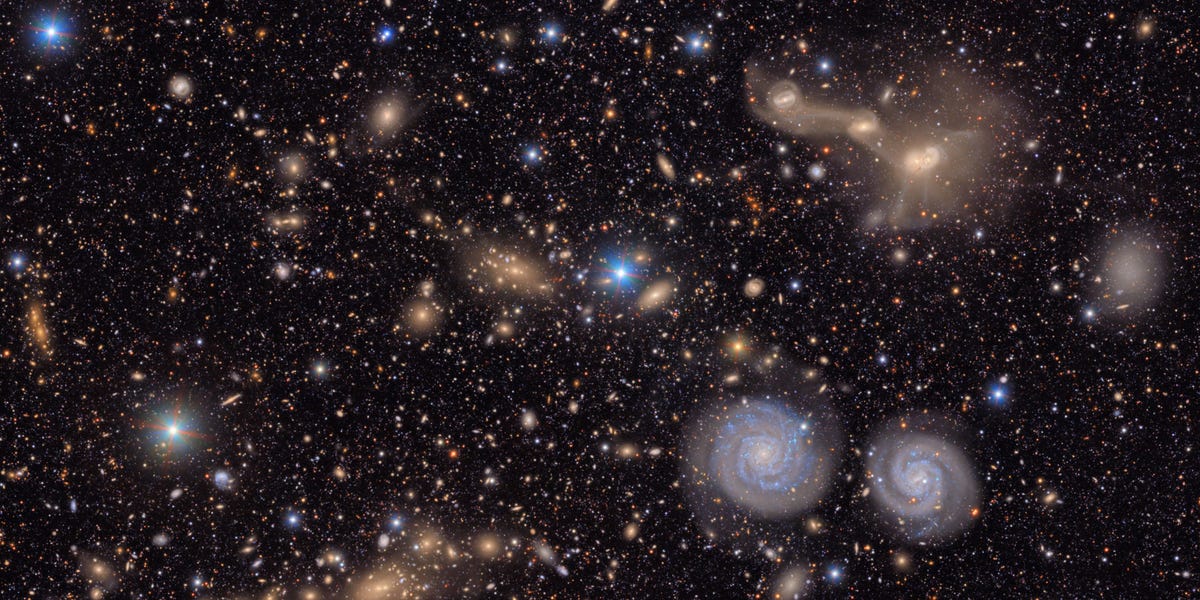By Darren Orf
Here’s what you’ll learn when you read this story:After more than a decade under construction, the Vera Rubin Observatory has released its first images, which contain millions of galaxies. These first images are only the brief, initial glimpse of the observatory’s 10-year Legacy Survey of Space and Time (LSST), which will discover new objects in the night sky while also (hopefully) answering questions about dark matter and dark energy. As a ground-based telescope, the Vera Rubin Observatory will be a perfect companion to space-based telescopes like the James Webb Space Telescope, as its sweeping view will completely scan the night sky every three days.On August 1, 2014, workers began construction of the Large Synoptic Survey Telescope (LSST) perched atop Cerro Pachón in Chile’s Atacama Desert. Fast forward a decade later, and the LSST—now called the Vera C. Rubin Observatory, named for the American astronomer whose groundbreaking work provided evidence for the existence of dark matter—is finally ready to start doing some serious science.Its main mission will be the Legacy Survey of Space and Time (confusingly also abbreviated LSST), which will ceaselessly scan the night sky continuously for 10 years, noting every visible change along the way. Vera Rubin is particularly well-suited for this task—with a 28-foot-wide primary mirror, and 11-foot-wide secondary mirror, and the largest digital camera ever constructed, this terrestrial telescope can move its 300-ton bulk one full rotation in a half a minute at full speed, according to The New York Times. The amount of data Rubin will collect in the next year alone will be more than all other optical observatories combined. To put it mildly, it’s an exciting time.To celebrate the beginning of its operation, the observatory has released the first images captured by the telescope. A combination of 678 different images, the photo above shows that brilliant Trifid nebula (top right) with the Lagoon nebula (bottom left), which is located more than 4,000 light-years from Earth. The lead image of this article (an in-depth look at the Virgo cluster) is only 2 percent of a full Rubin image, which would actually require 400 ultra high-definition TVs to display. Below is a labeled image of a swath of galaxies and stars—some of which we know, and many of which we’ve never seen before.“These images vividly showcase the unprecedented power that Rubin will use to revolutionize astronomy and our understanding of the Universe,” astronomers Manda Banerji and Phil Wiseman from the University of Southampton wrote in The Conversation. “Rubin is truly transformative, thanks to its unique combination of sensitivity, vast sky area coverage and exceptional image quality.” It’s a big moment for ground-based astronomy, which has often been eclipsed by groundbreaking discoveries made by space-based telescopes like Hubble and JWST. While it’s true that these floating telescopes offer a ton of benefits—chief among them being that they circumvent atmospheric interference and the increasing annoyance of satellite disruption (think Starlink)—the benefits of ground-based observatories far outweigh these visual costs. For one, these telescopes can be easily maintained and—crucially—upgraded with the latest and greatest technologies because… you know… they’re on the ground. And without the need for payload restrictions, ground-based telescopes can be absolutely gargantuan (look no further than the adequately named Extremely Large Telescope, also under construction in the Atacama Desert). A quick comparison: JWST’s Near Infrared Camera has a field of view of roughly 0.05 square degrees, whereas Vera Rubin has a full 9.6 square degrees. That means it can simply see way more sky than its space-based cousins. Rubin will also be able to produce incredibly high-definition photographs in just a few days, rather than the few years needed by other telescopes.At the end of its 10-year LSST mission, Rubin will provide invaluable data for investigating dark energy and dark matter, as well as information regarding some 20 billion galaxies. Rubin will also observe billions of objects on more than 800 separate occasions, which will create a kind of astronomical movie detailing the evolution of the night sky over time. Especially excitingly, it will capture asteroids as they move through the Solar System. The Observatory estimates that LSST will discover five million asteroids in the next few years alone—five times more than what humanity has discovered in the last two centuries.After decades of waiting, it’s time for the science to finally commence. “[Vera Rubin] represents the culmination of about two decades of dedication, innovation, and collaboration by a global team,” Željko Ivezić, Director of Rubin Observatory Construction, said in a press statement. “With construction now complete, we’re turning our eyes fully to the sky—not just to take images, but to begin a whole new era of discovery.”
